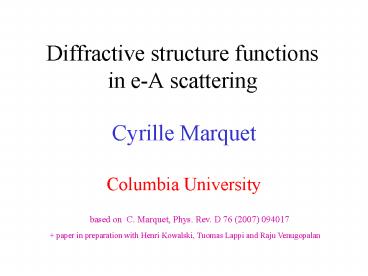Diffractive structure functions in e-A scattering - PowerPoint PPT Presentation
Title:
Diffractive structure functions in e-A scattering
Description:
with nuclear DPDFs (leading-twist shadowing) ... momentum fraction of the struck parton with respect to the Pomeron ... the dipole then interacts with the target ... – PowerPoint PPT presentation
Number of Views:27
Avg rating:3.0/5.0
Title: Diffractive structure functions in e-A scattering
1
Diffractive structure functionsin e-A scattering
Cyrille Marquet Columbia University
based on C. Marquet, Phys. Rev. D 76 (2007)
094017
paper in preparation with Henri Kowalski,
Tuomas Lappi and Raju Venugopalan
2
Motivations
- diffraction probes QCD in a different way than
inclusive measurements colorless t-channel
exchanges, Pomerons, , the large fraction of
events (10 ) observed at HERA was not
expected ? a challenge for QCD
- proposal for an electron-ion collider (at BNL
or Jlab) by the EIC collaboration
an important part of the physics program is
diffraction a first measurement of the nuclear
diffractive structure functions
3
Diffractive deep inelastic scattering
eh center-of-mass energyS (kp)2?h
center-of-mass energyW2 (k-kp)2photon
virtualityQ2 - (k-k)2 gt 0 momentum
transfert (p-p)2 lt 0diffractive mass of the
final stateMX2 (p-pk-k)2
x momentum fraction of the struck parton with
respect to the hadron/nucleus
? momentum fraction of the struck parton with
respect to the Pomeron
xpom momentum fraction of the Pomeron with
respect to the hadron/nucleus
4
Collinear factorization
in the limit Q² ? ? with x fixed
- for inclusive DIS
a quarks, gluons
- perturbative evolutionof ? with Q2
Dokshitzer-Gribov-Lipatov-Altarelli-Parisi
non perturbative
5
Dipole factorization
in the limit x ? 0 with Q² fixed
- deep inelastic scattering (DIS)
the photon split into a dipole (QED
wavefunction ?(r,Q²) ) the dipole then interacts
with the target at small x, the dipole
cross-section is comparable to that of a pion,
even though r 1/Q ltlt 1/?QCD
computed in CGC contributions from all twists
in principle, two parameters the saturation
scale and the maximum dipole cross-section
in practice, depending how many practical
approximations are made 1 to 3 extra parameters
6
Comparison with HERA data
with proton tagging e p ? e X p
H1 FPS data (2006) ZEUS LPS data (2004)
without proton tagging e p ? e X Y
H1 LRG data (2006) MY lt 1.6 GeV ZEUS FPC
data (2005) MY lt 2.3 GeV
parameter-free predictions
description of DIS (250 points) and diffractive
DIS (450 points)
7
The ß dependence
Contributions of the different final states to
the diffractive structure function
tot F2D
at intermediate ? quark-antiquark (T)
at small ? quark-antiquark-gluon
at large ? quark-antiquark (L)
large ? measurements ? FLD
8
From protons to nuclei
following the approach of Kowalski-Teaney (2003)
?
averaged with the Woods-Saxon distribution
position of the nucleons
averaging allows to evaluate the saturation
scale
Kowalski, Lappi and Venugopalan (2007)
in diffraction, averaging at the level of the
amplitude corresponds to a final state where the
nucleus is intact
averaging at the cross-section level allows the
breakup of the nucleus into nucleons
9
Hard diffraction on nuclei
in progress with Kowalski, Lappi and Venugopalan
the ratios FAD / Fp D for each contributions
as a function of ß
quark-antiquark-gluon
lt 1 and const.
quark-antiquark (T)
gt 1 and const.
quark-antiquark (L)
gt 1 and decreases with ß
the decrease with (decreasing ß) of is
slower for a nucleus than for a proton
for Au nucleus, without breakup
10
The ratio F2D,A / F2 D,p
the ratio of the structure functions
the quark-antiquark-gluon contribution
is important only for very small values of ?, the
ratio gets constant and decreases with A
decreases with A
the quark-antiquark contribution dominates
11
Conclusions
- - CGC (saturation) phenomenology is very
successful at both HERA and RHIC - - the same dipole scattering amplitude describes
inclusive and diffractive DIS - global description with very few parameters
- after fitting a few parameters on inclusive
data, the parameter free predictions for
diffraction agree very well with the HERA data - - the model also describes vector meson (?, F,
J/?) production (total cross-sections and
t-spectra) with 2 additional parameters
Marquet, Peschanski and Soyez (2007) - Why do these high-energy QCD computations work so
well at HERA ? - we would understand better if this could be
tested with a future EIC - depending on the energy options, one could reach
Qs 2 GeV































